Plan checklist
Carla Salvador Shore
344 Mississauga Lake Road, Mississauga Lake
Planting plan created by The Land Between charity
Schedule A:
Plants & Property
Land Characteristics
This planting plan is designed based on the land characteristics identified during the day of the site visit. Plants are chosen according to the soil and light conditions on your property. The number of plants chosen for each planting compartment takes into account the square metre area of the space, as well as the amount of current vegetation cover. Your property is part of ecoZone: 5b
Land Characteristics by Compartment
| Length | Width | Area | pH | Soil | Moisture | Light | Height | |
|---|---|---|---|---|---|---|---|---|
| A | 0m | 0m | 0m2 | basic | sandy | moist | partial sun | |
| B | 0m | 0m | 0m2 | acidic | loamy | dry | partial sun | any |
| 0m | 0m | 0m2 |
Plant Selection Summary
The following shrubs and trees are chosen for their suitability and survivability given the current soil and light conditions in each compartment on your property, as well as preferable features.
| Plant Species | A | B | Potted | Bareroot | Wildflower |
|---|---|---|---|---|---|
| Sweet Gale | 5 | 5 | |||
| Bearberry | 6 | 6 | |||
| Wintergreen | 5 | 5 | |||
| Bush Honeysuckle | 3 | 3 | |||
| Virginia Creeper | 3 | 3 | |||
| Bunchberry | 16 | 16 | |||
| Subtotal | 5 | 33 | 19 | 0 | 19 |
| Totals | 38 | ||||
Plant Information
The following table summarizes key information about each plant selected for your property.
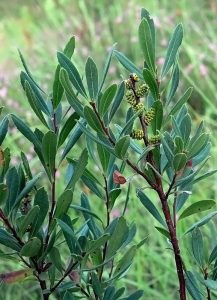
|
Sweet GaleHeight: 1-2m
Sweet Gale is a medium-sized shrub which grows into a thick bush about 1-2 m tall. This species produces 1-8 cm long, oblong-lanceolate leaves which are finely toothed at the tip and are spirally arranged. When bruised, these leaves give off a pleasant aroma. Male and female catkins are produced on separate plants. The seeds are dispersed from the female plants via water, as they float on two corky bracts. This shrub also provides a good food source for bird species that eat the seeds including Grouse, Chickadees, and Bluebirds. Mammal species like Beavers and White-Tailed Deer also browse on the twigs and leaves of this plant.
|
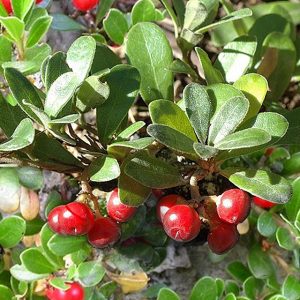
|
BearberryHeight: 20 cm
Bearberry is a low growing, evergreen shrub/ground cover species that grows about 20 cm tall. The leaves are dark green, leathery, shiny, ovate shaped, alternately arranged, and have entire margins. The flowers are tiny, urn shaped, white to pink colored, appear in drooping clusters, and bloom between April and May. Flowers are followed by bright red berries, which remain throughout the fall and winter. These berries are beneficial to wildlife species like birds and small mammals.
|
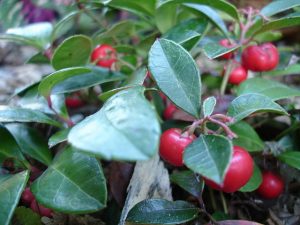
|
WintergreenHeight: 15 cm
Wintergreen is a medium-sized ground cover species that grows up to 15 cm in height. The leaves are glossy, dark-green, simple, oval shaped, and turn purple during the fall. Wintergreen is a visually appealing plant that produces small, white, bell-shaped flowers during the spring. This species yields edible, scarlet red berries during July, which persist throughout the winter months. These berries are a great food source for many song birds, squirrels, deer and a tasty treat for humans when added to pastries or salads. The name Wintergreen comes from the plants ability to keep it's leaves throughout the winter. Wintergreen is unique because their leaves emit a minty aroma when crushed. Wintergreen oil is commonly used in the flavoring of gum and toothpaste.
|
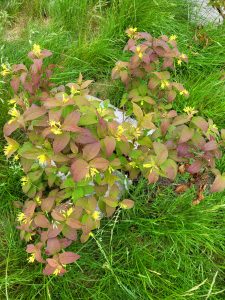
|
Bush HoneysuckleHeight: 1m
The Bush Honeysuckle is a small, hardy, deciduous shrub that rarely grows taller than 1 m in height. The leaves are simple, oppositely arranged, ovate shaped, and have finely toothed margins. During the spring and summer, the leaves are dark green in colour, then in the fall they take on a variety of colours ranging from a deep purple to light yellow. The flowers are small, showy, yellow to orange colored, trumpet shaped, appear in clusters on the tips of branches, and bloom between June and July. The flowers are beneficial to pollinator species, including hummingbirds and butterflies. The roots of the Bush Honeysuckle are fibrous, giving it the ability to form thickets and making it an ideal shrub to plant for erosion control.
|
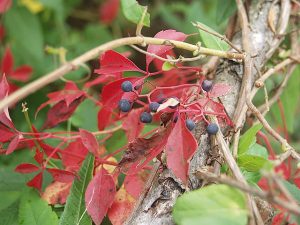
|
Virginia CreeperHeight: 15 m
The Virginia Creeper is a deciduous, woody vine species which can grow up to 15 m if near a tall structure or tree. The leaves are palmately compound with five ovate shaped leaflets. These leaves are largely toothed and turn bright red and orange during the fall. Despite having inconspicuous flowers, this species produces incredible dark blue berries, which are beneficial to birds and small mammals. This vine can grow 2-3 m per growing season, thus pruning and maintenance may be required. Virginia Creeper may sometimes be confused with Poison Ivy as younger plants will only have three leaflets instead of five. This plant can grow aggressively so should be planted where it has plenty of space to spread. Some shoreline landowners choose to plant this around rip rap/loose stone retaining walls for a more natural appearance. The root system is beneficial for quickly controlling erosion.
|
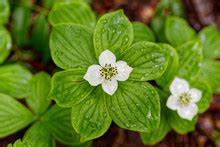
|
BunchberryHeight: 15 cm
Bunchberry is a deciduous ground cover species that can grow around 15 cm in height. This plant may also be known by the common name Creeping-Dogwood. The leaves are deep green, oppositely arranged, oval shaped, and glossy. The flowers are showy, white colored, and bloom between May and June. These flowers produce bright red berries that are edible to humans and beneficial to wildlife species, like birds and small mammals.
|
Compartment A
Naturalization Area
For added biodiversity (amphibians and zooplankton) and to stabilize shore/reduce wave action pH: basic
pH: basic-
 Moisture: moist
Moisture: moist -
 Soil Type: sandy
Soil Type: sandy -
 Light conditions: partial sun
Light conditions: partial sun
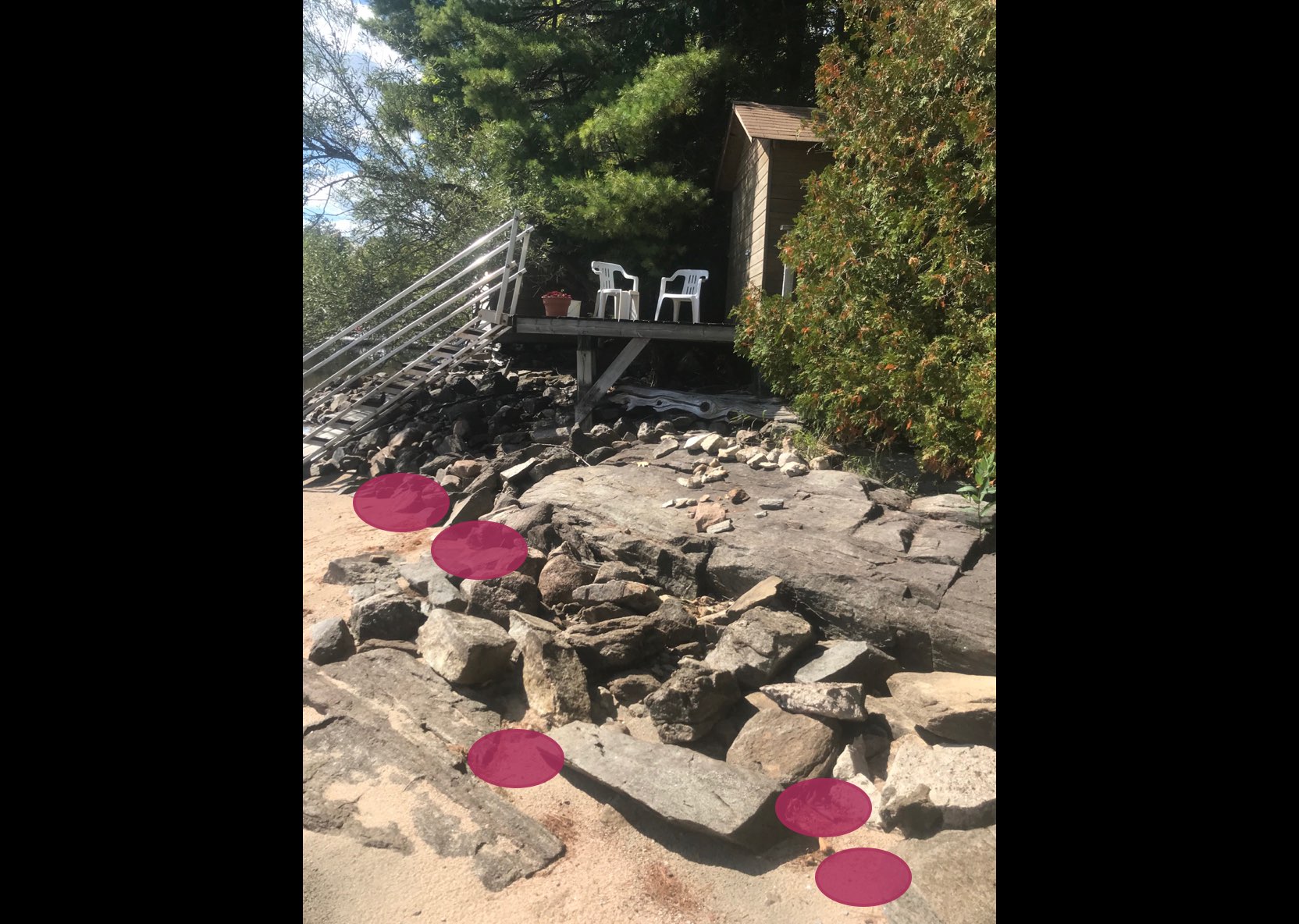
Compartment B
Naturalization Area
To increase biodiversity in front of the cottage; maintain views; compete with invasive species pH: acidic
pH: acidic Depth: potted, wildflowers
Depth: potted, wildflowers-
 Moisture: dry
Moisture: dry -
 Soil Type: loamy
Soil Type: loamy  Plant Height: any
Plant Height: any-
 Light conditions: partial sun
Light conditions: partial sun

Schedule B
Financial Summary
Project by: The Land Between charity
Shoreline Re-Naturalization Starter Kit includes: free site visit, customized re-naturalization planting plan for your shoreline property, native plants including free bare root (small) and potted (large) plants and wildflowers, coconut fibre pads to deter grass from growing around new plantings, tree guards for all deciduous trees, mulch for your wildflowers, Plant Care Guide with instructions on how to take care of your new plants, Habitat Creation Guide and a Wildflower Garden Guide.
Our planting plans are created onsite with you and provide detailed information and plans to re-naturalize your shoreline property. We take photos of areas for planting and overlay native plants that are well suited to your property based on site conditions such as soil type and sunlight availability.
We will work with you to create a plan that works for you including options for low growing plants in areas where views are important.
| Item | Quantity | Cost/Item | Subtotal |
|---|---|---|---|
| Starter Kit fee | $250 | ||
| Free potted plants | 8 | $0 | $0 |
| Paid potted plants | 11 | 13.00 | 143.00 |
| Free bareroot plants | 0 | $0 | $0 |
| Free wildflowers | 10 | $0 | $0 |
| Paid wildflowers | 9 | 10.00 | 90.00 |
| Total costs | 483.00 |
Schedule C
Project Agreement
Stewardship Agreement
Please indicate your agreement to this proposed plan by signing the following Stewardship Agreement and submitting it, along with your financial contribution, to:
The Land Between charity
Box 1368, 6712 Gelert Road,
Plant Availability
Please note that plant species may need to be changed based on plant stock availability at the time of ordering.
Project Completion
Upon receiving your signed stewardship agreement and financial contribution, a date will be booked for you to pick up your Natural Edge Kit. The Land Between charity will supply all plants and materials. If you are paying for the planting to be completed for you, a date will be arranged for The Land Between charity to plant your shoreline, bringing the plants and materials with them. If there are particular dates that you would prefer, we will do our best to accommodate your requests.
The Natural Edge Stewardship Agreement with The Land Between charity
Agreement made this Day of the Month of in the Year .
BETWEEN Carla Salvador 344 Mississauga Lake Road Kawartha Lakes Ontario (Hereinafter called the OWNERS)
AND The Land Between charity Box 1368, 6712 Gelert Road, (Hereinafter called TLB)
WHEREAS the Owners and TLB have met and discussed plans for shoreline naturalization on the specified area(s) in Schedule A existing on the Owners’ land;
WHEREAS the Owners indicate approval of the project as proposed; and
WHEREAS the project is, or will be for the benefit of the Owners and others;
NOW THEREFORE THE PARTIES AGREE AS FOLLOWS:
1. This Agreement shall be in effect for a period of 5 years, commencing with the date of this Agreement.
2. The Owners and TLB agree that the areas where the work is to be performed is as described in Schedule A.
3. The Owners agree to pick up their Natural Edge Starter Kit from TLB’s office and plant their shoreline within two days of receipt. The Owners will provide “after” photos of the work completed to be used for reporting purposes. If the Owners wish to have the planting completed for them, then TLB or it’s contractors, employees and agents will complete the planting at cost, as indicated in Schedule B.
4. If the planting is to be completed by TLB, then the Owners grant TLB, its contractors, employees and agents, the right to enter the property to perform the work agreed upon as outlined in Schedule A. In addition, TLB, its contractors, employees and agents may inspect the work performed for the purposes of monitoring the project and survival assessment, with prior agreement with Owners for date and time of inspection.
5. The Owners agree to contribute the “Landowner contribution” and pay the costs indicated in Schedule B.
6. In instances where the Owners are to pay TLB for work to be performed (outlined in Schedule A), the Owners agree to provide payments to TLB prior to the commencement of that operation. Failure of payment shall constitute a breach of this Agreement and the Owners agree that this Agreement will be terminated and thereupon the Owners agree to pay TLB the estimated costs of the operations of the project completed to date, if any.
7. The Owners agree, if necessary, to perform a reasonable amount of maintenance, which is described in the Native Plant Care Guide, available at naturaledge.watersheds.ca.
8. If a contractor is required to perform the work outlined in Schedule A, then the contractor carrying out the work on the land described will be required to take out and furnish evidence of a comprehensive policy of public liability and property damage coverage. The contractor and their workers will be required to be in good standing with the Workplace Safety and Insurance Board (WSIB) prior to performing the work.
9. The Owners agree not to remove, destroy or alter the project without prior consultation and approval of TLB. Pruning and trimming planted nursery stock, or adding replacement native nursery stock is exempt.
10. The Owners agree not to mow the planted area.
11. The Owners do acknowledge that TLB, its contractors, employees and agents, having performed said works, are not under further obligation with respect to survival of nursery stock, inspection, or maintenance.
12. The Owners, in the absence of negligence, hereby remise, release and forever discharge TLB, its contractors, employees and agents from all claims and demands for injuries, including death, loss, damages and costs in any way related to or connected with installation and maintenance of the work described or resulting from any deleterious effects of the work to the land or to the lands and buildings thereon retained by the Owners.
IN WITNESS WHEREOF the parties have agreed to the contents of this plan; SIGNED:
About this program
About The Land Between charity
The Land Between is a region stretching across south-central Ontario from the Georgian Bay Coastline to the Ottawa River. It lies between the Canadian Shield and St. Lawrence Lowlands and has species from both north and south. The region has the highest habitat diversity in Ontario; more lakes, wetlands, and rivers than anywhere in the province; the majority of rock barrens and alvar habitats; and is home to more skinks, turtles, hummingbirds than anywhere in Ontario. It is melting pot of species diversity and the last refuge for many disappearing wildlife and important mammals in southern Ontario. The Land Between charity cares for and conserves this region through community based and multi partnered programs, by working with landowners and through grit and perseverance. The Land Between charity is Cottage Country's own conservation organization.
This program was created by Watersheds Canada
We believe that every person has the right to access clean and healthy lakes and rivers in Canada. At Watersheds Canada, we work to keep these precious places naturally clean and healthy for people and wildlife to continue using for years to come. We love working with others to meet the needs of local communities, whether you’re a concerned citizen, a landowner, a lake association looking for help, or a coalition of groups interested in activating your local community.

